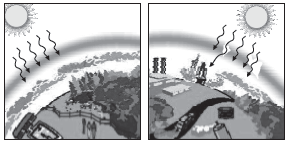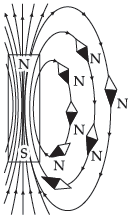See below CBSE Class 10 Science Term 1 Sample Paper Set B with solutions. We have provided CBSE Sample Papers for Class 10 Science as per the latest paper pattern issued by CBSE for the current academic year. All sample papers provided by our Class 10 Science teachers are with answers. You can see the sample paper given below and use them for more practice for Class 10 Science examination.
CBSE Sample Paper for Class 10 Science Term 1 Set B
Section – A
1. A homologous series is a series of organic compounds which belong to the same family (i.e. possess same functional group) and show similar chemical properties.
(a) Write chemical formula of two consecutive members of a homologous series of alcohol.
(b) State the part of these compounds that determines their
(i) physical properties,
(ii) chemical properties.
Ans. (a) Two consecutive members of homologous series are CH3OH and C2H5OH.
(b) (i) Physical properties:- Hydrocarbon chain i.e. CH3 in CH3CH2OH and CH3CH2 in CH3CH2CH2OH
(ii) Chemical properties:- Functional group i.e. −OH
2. The electronic configuration of two elements ‘A’ and ‘B’ are 2, 8, 3 and 2, 8, 7 respectively.
(a) Find the atomic number of these elements.
(b) State the nature and formula of the compound formed by the union of these two elements.
Ans. (b) AB3 – It is an ionic compound.
3. In order to perform an experiment, Kajal took three bread slices and kept them in the following conditions:
(i) Slice 1 in dried and dark place.
(ii) Slice 2 in moist and dark place.
(ii) Slice 3 in refrigerator under moist conditions.
(a) What would she observe in each of the above conditions?
(b) Name the kind of organisms that reproduce by spore formation.
Ans. (b) Rhizopus reproduces by spore formation.
4. (a) Sneha was studying human reproduction. Her class teacher asked her to state the name of the events which occur in the reproductive system of a human female:
(i) if egg is fertilised.
(ii) if egg is not fertilised.
(b) Mention the changes that take place in uterus in case (i).
Ans. (a) (i) Pregnancy (ii) Menstruation.
(b) In first case, the lining of uterus becomes thick and spongy, richly supplied with blood, helps in implantation of the embryo.
5. Nazia performed a monohybrid cross between homozygous tall pea plants denoted by TT and homozygous short pea plants denoted by tt. She obtained only tall plants denoted by Tt in the F1 generation. However, in F2 generation she obtained both tall and short pea plants. Does the given information, explains the law of dominance? If yes, explain.
Ans. Recall monohybrid cross (cross between pure tall pea plant and pure dwarf pea plant).
OR
Mr. Naresh and his wife have attached earlobes (recessive trait) and are professional dancers. They told their colleagues that their offspring would also have attached earlobes and will be a good dancer. Is their notion right? Support your answer with suitable reasons.
Ans. Attached earlobe or free earlobe is an inherited trait.
6. An a-particle enters a uniform magnetic field at right angles to it as shown in figure.

(a) Stating the relevant principle, identify the direction in which this a-particle moves. Give reason to support your answer.
(b) State whether an alpha particle will experience any force in a magnetic field if it is placed in the field at rest.
Ans. (a) Fleming’s left hand rule is followed.
(b) Alpha particle will not experience any force.
OR
Two student were playing with two magnets. They observed the magnets were sometimes attracting and sometimes repelling from their ends. They asked about magnets from their physics faculty. He demonstrated an activity with magnet’s ends and draw a diagram. Study the diagram given below.

(a) Identify the poles marked P and Q as North Pole or South Pole. Give reason in support of your answer.
(b) What is the direction of magnetic field lines inside a bar magnet ?
Ans. (a) The poles P and Q are north poles because the field lines travel from north pole to south pole.
(b) From south pole to north pole
7. The figure shows a food web arranged into trophic levels.

How many energy-transferring steps away from the sun is the deer? How do you know?
Ans. The deer is on the second trophic level, so it is two steps away from the sun.
OR

(a) Name and explain the phenomenon shown in the diagram.
(b) List out any three effects of the above phenomenon on humans.
Ans. (a) Ozone Layer depletion
(b) The depletion of Ozone leads to UV light entering the earth atmosphere, which can lead to skin cancer and can also play a major role in development of cataract.
Section – B
8. In the following table, six elements A, B, C, D, E and F (here letters are not the usual symbols of the elements) of the Modern Periodic Table with atomic numbers 3 to 18 are given:

(a) Which of these is
(i) a noble gas
(ii) a halogen
(b) If B combines with F, what would be the formula of the compound formed?
(c) Write the electronic configurations of C and E.
Ans. (a) (i) G with atomic number 10 is a noble gas because it has complete octet.
(ii) F with atomic number 17 is a halogen.
(b) B with atomic number 11 has 1 valence electron and F with atomic number 17 has 7 valence electrons so the formula of the compound formed would be BF.
(c) Electronic configuration of C and E are
E8– 2, 6
C12– 2, 8, 2
9. Ajay’s friend Nikhil has four sons and one daughter. He believes that he produces more sperms with Y chromosome. Do you agree? With suitable reasons, justify whether he is right or wrong in thinking this way.
Ans. There is 50% chances of production of sperms carrying Y chromosome or X chromosome.
10. (a) From the given table, identify the metal / alloy that should be used to make the following gadgets:

(i) Heating element of electric geysers.
(ii) Filament of incandescent bulbs.
(b) An electric iron has rating of 750 W, 220 V. Calculate:
(i) Current required and,
(ii) Its resistance when it is in use.
Ans. (a) (i) Nichrome (ii) Tungsten
(b) Use the formula, P = VI and R = V/I
11. Carefully study the circuit diagram and calculate the value of resistance ‘x‘.

Ans. In Parallel connection: 1 / Req = 1 / R1 + 1 / R2 + 1 / R3
In series connection : Req = R1 + R2 + R3
12. Calculate the equivalent resistance between the point A and B of the circuit given below.

Ans. Total resistance in the path ACB, i.e., R1=8.5Ω+3.5Ω=12Ω
Since R1 and R2 are in parallel, the effective resistance between the points A and B, i.e.,

13. The activities of man had adverse effects on all forms of living organisms in the biosphere. Unlimited exploitation of nature by man disturbed the delicate ecological balance between the living and nonliving components of the biosphere. The unfavourable conditions created by man himself threatened the survival not only of him but also of the entire living organisms on the mother earth. One of your classmates is an active member of ‘Eco club’ of your school which is creating environmental awareness amongst the school students, spreading the same in the society and also working hard for preventing environmental degradation of the surroundings.
(a) Why is it necessary to conserve our environment?
(b) What does the green and blue dustbin signifies.
Ans. (a) It is necessary to conserve environment for many reasons, including protecting ozone layer , maintaining animal and human food chains, preserving potable water and making efficient use of non-renewable resources
(b) Green dustbin is used to deposit biodegradable wastes and blue dustbin is used to deposit non-biodegradable waste. Separating biodegradable wastes from non-biodegradable wastes is very important and if not done at the begining it will become a very long and expensive process.
Section – C
14. While doing experiment on pea plants. A scientist found that pea plants can have round seeds or wrinkled seeds. Also, one of the phenotypes i.e. round seed is completely dominant over the other i.e. wrinkled. So, one day he decides to pollinate one flower of a plant with round seeds using pollen from plant with wrinkled seeds.
(a) Mention the genes for the traits of parents.
(b) State the trait of F1 hybrids.
(c) Write the ratio of F2 progeny obtained from this cross. What is the name of the cross?
Ans. Recall genotypic and phenotypic ratio of monohybrid cross.
OR
Why are the traits acquired during the life time of an individual not inherited? Explain.
Ans. This happens because an acquired trait involves change in non-reproductive tissues (somatic cells) which cannot be passed on to germ cells or the progeny. Therefore, these traits cannot be inherited.
15. Sanjana described a magnetic field by drawing the magnetic field lines. She explained that when a small north magnetic pole is placed in the magnetic field created by a magnet, it will experience a force. And if the North Pole is free, it will move under the influence of magnetic field. Since the direction of magnetic field line is the direction of force on a north pole, so the magnetic field lines always begin from the N-pole of a magnet and end on the S-pole of the magnet. Inside the magnet, however the direction of magnetic field lines is from the S-pole of the magnet to the N-pole of the magnet. Thus, the magnetic field lines are closed curves. When a small compass is moved along a magnetic field line, the compass needle always sets itself along the line tangential to it. So, a line drawn from the south pole of the compass needle to its north pole indicates the direction of the magnetic field at that point.

Based on the given passage answer the following questions:
(a) What is meant by magnetic field lines ?
(b) What does the degree of closeness of magnetic field lines near the poles signify ?
(c) Give two uses of a magnetic compass.
Ans. (b) Degree of closeness of magnetic field lines show strong magnetic field in the region.
OR
What are the characteristics of magnet field lines?
Ans. 1. The field is tangent to the magnetic field line.
2. Field strength is proportional to the line density.
3. Field lines cannot cross.
4. Field lines are continuous loops



